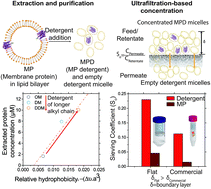Our official English website, www.x-mol.net, welcomes your
feedback! (Note: you will need to create a separate account there.)
Improving extraction and post-purification concentration of membrane proteins†
Analyst ( IF 3.6 ) Pub Date : 2017-12-01 00:00:00 , DOI: 10.1039/c7an01470h Hasin Feroz 1, 2, 3 , HyeYoung Kwon 1, 2, 3 , Jing Peng 2, 3, 4 , Hyeonji Oh 1, 2, 3 , Bryan Ferlez 2, 3, 5 , Carol S. Baker 2, 3, 5 , John H. Golbeck 2, 2, 3, 5, 6 , Guillermo C. Bazan 3, 7, 8, 9 , Andrew L. Zydney 1, 2, 3 , Manish Kumar 1, 2, 3
Analyst ( IF 3.6 ) Pub Date : 2017-12-01 00:00:00 , DOI: 10.1039/c7an01470h Hasin Feroz 1, 2, 3 , HyeYoung Kwon 1, 2, 3 , Jing Peng 2, 3, 4 , Hyeonji Oh 1, 2, 3 , Bryan Ferlez 2, 3, 5 , Carol S. Baker 2, 3, 5 , John H. Golbeck 2, 2, 3, 5, 6 , Guillermo C. Bazan 3, 7, 8, 9 , Andrew L. Zydney 1, 2, 3 , Manish Kumar 1, 2, 3
Affiliation

|
Membrane proteins (MPs), despite being critically important drug targets for the pharmaceutical industry, are difficult to study due to challenges in obtaining high yields of functional protein. Most current extraction efforts use specialized non-ionic detergents to solubilize and stabilize MPs, with MPs being concentrated by ultrafiltration (UF). However, many detergents are retained during the UF step, which can destabilize MPs and/or interfere with their characterization. Here, we studied the influence of detergent selection on the extraction and UF-based concentration of biomedically-relevant MPs, the light-driven sodium and chloride transporters, KR2 and halorhodopsin (pHR) which are also model proteins for more complex mammalian rhodopsins. We also designed a flat-bottomed centrifugal filter that can concentrate MPs with enhanced removal of free detergents by promoting concentration polarization (CP). We tested the performance of this new filter using four commonly employed MP detergents, octyl-β-D maltoside (OM), decyl-β-D maltoside (DM), dodecyl-β-D maltoside (DDM) and octyl-β-D glucoside (OG), over a range of detergent and salt concentrations. Detergent passage is significantly higher for the flat-bottomed filter achieving up to 2-fold greater sieving of detergent in DM-solubilized pHR system due to the high degree of CP. We observe more efficient, up to 5-fold higher extraction of KR2 in the presence of a longer 12-carbon alkyl chain detergent, DDM compared to a shorter 8-carbon detergent, OM. Assuming complete binding and elution of the extracted protein, DDM-based extraction of KR2 could lead to a potential 7-fold improvement in purification yields compared to conventional methods which yield ∼1 mg MP per liter of cell culture. However, the longer chain detergents like DDM form larger micelles that are difficult to remove by UF. Thus, there exists a trade-off between choosing a detergent that will enable efficient extraction of MP while showing easier removal during subsequent UF. The extraction efficiency and UF-based separation of detergent micelles provide insights for other applications involving detergent–mediated separation/extraction.
中文翻译:

改善膜蛋白的提取和纯化后浓度†
膜蛋白(MPs)尽管对于制药行业而言是至关重要的药物靶标,但由于要获得高产量的功能蛋白存在挑战,因此很难进行研究。当前大多数提取工作都使用专门的非离子型去污剂来溶解和稳定MP,MP通过超滤(UF)进行浓缩。但是,在超滤步骤中会保留许多洗涤剂,这可能会使MP不稳定并/或干扰其表征。在这里,我们研究了洗涤剂选择对生物医学相关MP的提取和基于UF的浓度,光驱动的钠和氯转运蛋白,KR2和卤代视紫红质(pHR)的影响,它们也是更复杂的哺乳动物视紫红质的模型蛋白。我们还设计了一个平底离心过滤器,该过滤器可以浓缩MP,并通过促进浓差极化(CP)增强对游离洗涤剂的去除。我们使用四种常用的MP去污剂,辛基-β-D麦芽糖苷(OM),癸基-β-D麦芽糖苷(DM),十二烷基-β-D麦芽糖苷(DDM)和辛基-β-D测试了这种新型过滤器的性能洗涤剂和盐浓度范围内的葡萄糖苷(OG)。对于扁平底部的过滤器来说,洗涤剂的通过率要高得多,这归因于CP含量高,在DM增溶的pHR系统中实现了高达2倍的去污剂筛分。我们观察到,与较短的8碳洗涤剂OM相比,在较长的12碳烷基链洗涤剂DDM的存在下,KR2的提取效率更高,高达5倍。假设提取的蛋白质完全结合并洗脱,与传统方法相比,基于DDM的KR2提取可导致纯化产率提高7倍,而传统方法每升细胞培养物可产生约1 mg MP。但是,较长链的去污剂(如DDM)会形成较大的胶束,很难用UF去除。因此,在选择能够有效提取MP并在随后的UF中去除更容易的去污剂之间存在一个权衡。洗涤剂胶束的提取效率和基于UF的分离为涉及洗涤剂介导的分离/萃取的其他应用提供了见识。因此,在选择能够有效提取MP的同时在随后的UF中显示更容易去除的去污剂之间存在一个权衡。洗涤剂胶束的提取效率和基于UF的分离为涉及洗涤剂介导的分离/萃取的其他应用提供了见识。因此,在选择能够有效提取MP并在随后的UF中去除更容易的去污剂之间存在一个权衡。洗涤剂胶束的提取效率和基于UF的分离为涉及洗涤剂介导的分离/萃取的其他应用提供了见识。
更新日期:2017-12-01
中文翻译:

改善膜蛋白的提取和纯化后浓度†
膜蛋白(MPs)尽管对于制药行业而言是至关重要的药物靶标,但由于要获得高产量的功能蛋白存在挑战,因此很难进行研究。当前大多数提取工作都使用专门的非离子型去污剂来溶解和稳定MP,MP通过超滤(UF)进行浓缩。但是,在超滤步骤中会保留许多洗涤剂,这可能会使MP不稳定并/或干扰其表征。在这里,我们研究了洗涤剂选择对生物医学相关MP的提取和基于UF的浓度,光驱动的钠和氯转运蛋白,KR2和卤代视紫红质(pHR)的影响,它们也是更复杂的哺乳动物视紫红质的模型蛋白。我们还设计了一个平底离心过滤器,该过滤器可以浓缩MP,并通过促进浓差极化(CP)增强对游离洗涤剂的去除。我们使用四种常用的MP去污剂,辛基-β-D麦芽糖苷(OM),癸基-β-D麦芽糖苷(DM),十二烷基-β-D麦芽糖苷(DDM)和辛基-β-D测试了这种新型过滤器的性能洗涤剂和盐浓度范围内的葡萄糖苷(OG)。对于扁平底部的过滤器来说,洗涤剂的通过率要高得多,这归因于CP含量高,在DM增溶的pHR系统中实现了高达2倍的去污剂筛分。我们观察到,与较短的8碳洗涤剂OM相比,在较长的12碳烷基链洗涤剂DDM的存在下,KR2的提取效率更高,高达5倍。假设提取的蛋白质完全结合并洗脱,与传统方法相比,基于DDM的KR2提取可导致纯化产率提高7倍,而传统方法每升细胞培养物可产生约1 mg MP。但是,较长链的去污剂(如DDM)会形成较大的胶束,很难用UF去除。因此,在选择能够有效提取MP并在随后的UF中去除更容易的去污剂之间存在一个权衡。洗涤剂胶束的提取效率和基于UF的分离为涉及洗涤剂介导的分离/萃取的其他应用提供了见识。因此,在选择能够有效提取MP的同时在随后的UF中显示更容易去除的去污剂之间存在一个权衡。洗涤剂胶束的提取效率和基于UF的分离为涉及洗涤剂介导的分离/萃取的其他应用提供了见识。因此,在选择能够有效提取MP并在随后的UF中去除更容易的去污剂之间存在一个权衡。洗涤剂胶束的提取效率和基于UF的分离为涉及洗涤剂介导的分离/萃取的其他应用提供了见识。









































 京公网安备 11010802027423号
京公网安备 11010802027423号